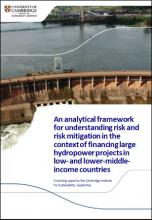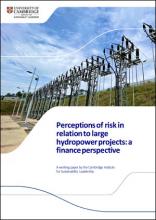February 2021 – The purpose of this framework is to provide potential financiers and investors with a better understanding the risk profile of these projects to improve their likelihood of obtaining sustainable finance.
Read the working papers
Hydropower projects can support sustainable development, but the perception of them as ‘risky’ investment can make it difficult for developers to access finance. Under the FutureDAMS research project, CISL Researchers Dr Judith Plummer Braeckman, Dr Sanna Markkanen and Dr Nina Seega developed a new framework for identifying, measuring and managing risk for large hydropower projects in low-income countries (LICS) and lower-middle income countries (LMICs). The purpose of this framework is to provide potential financiers and investors with a better understanding the risk profile of these projects to improve their likelihood of obtaining sustainable finance.
Demand for electricity in LIC and LMICs is increasing. When sustainably implemented, large hydropower can provide an affordable, reliable, and modern source of low-carbon electricity, supporting economic and social development and environmentally sustainable industrialisation.
However, financing large hydropower projects in LICs and LMICs can be challenging. There is often a shortage of public funds, meaning that infrastructure projects that can generate a revenue need to be increasingly financed and developed by private sector actors through arrangements such as public–private partnerships. To attract private sector finance, these projects need to be able to generate a stable and predictable return on investment. Private sector financiers are also unlikely to engage in ventures that they consider to be too risky, including capital intensive projects (such as large hydropower) in unfamiliar country contexts.
Private sector financiers need access to information that enables them to better understand the risks associated with infrastructure investments that may otherwise be regarded as ‘too risky’.
A framework was developed to outline the technical, environmental and social, financial and government risks and what measures can mitigate these risks.
Click here to access the interactive risk analysis and mitigation framework
Through a 2-part series of working papers, the project team have developed a tool to support public and private sector actors. The first paper establishes an analytical framework. The framework can be used as a structure for identifying, measuring and managing risk for large hydropower projects in LICs and L-MICs. It provides a systematic approach to the analysis of risk which can aid governments, developers, lenders and investors in maximising the likelihood of a project obtaining sustainable finance.
The second paper integrates original qualitative and quantitative data on financiers’ perceptions of risk into the framework. The findings suggest that many of the greatest risks associated with large public-private-partnership (PPP) hydropower projects in LICs and LMICs are those that may cause reputational damage to the parties involved, such as social and environmental risks.
The results presented in the papers will enable governments and developers to take targeted action to reduce risk and thus facilitate more effective use of the PPP financing model for large renewable energy infrastructure projects in LICs and LMICs, where additional large-scale sustainable electricity generation capacity is most needed.





